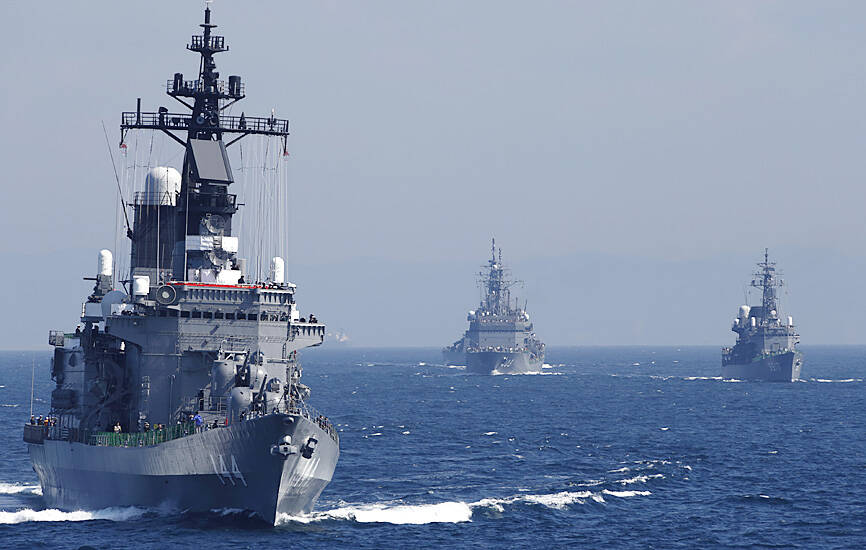There are four scenarios for how Japan could become involved in the event that China were to attack Taiwan, said Tang Ming-hua (唐明華), a researcher at the Institute for National Defense and Security Research.
For Japan, the possibility of avoiding war entirely while still preserving alliance credibility is becoming increasingly challenging, he said in an article published by the institute.
Tang made the statements after Japanese Prime Minister Sanae Takaichi on Nov. 7 said that if China were to use force or impose a blockade that undermines peace in the Taiwan Strait and threatens Japan’s national security, Tokyo could invoke security legislation from 2015 and treat the situation as a “survival-threatening crisis.” This is the first time a Japanese prime minister has publicly elevated the Taiwan issue to the level of an existential threat.

Photo: Bloomberg
Tang said Japan could respond to such a contingency in one of four ways. In the first scenario, Japan could adopt a defensive and restrained posture, not invoking the security law and focusing instead on domestic defense measures such as strengthening surveillance over its southwestern islands, improving missile defense and evacuating Japanese nationals in Taiwan. This approach, reflecting possible Japanese reluctance to enter conflict, could harm trust within the Japan-US alliance.
In the second scenario, Japan could say the situation has significantly impacted it, and order the Japan Self-Defense Forces to provide rear-area logistical support to US forces. This would include access to bases, intelligence sharing, supply and medical support, and sea lines of communication protection. Japan would avoid direct combat, but could still be viewed by China as supporting the US war effort, exposing itself to retaliation.
A third scenario involves Japan declaring a “survival-threatening crisis,” enabling it to exercise collective self-defense under the security law. Japan could intercept Chinese People’s Liberation Army missiles or ships threatening its territory or US bases, escort US vessels through key chokepoints such as the Miyako Strait or Bashi Channel, conduct anti-submarine operations or undertake joint air missions to protect Japanese airspace and alliance assets. Although Tokyo would avoid engaging in direct combat over Taiwan itself, it would in effect be participating in the conflict.
The fourth, and most extreme, scenario sees Japan and the US jointly engaging in full military operations around Taiwan and within the first island chain. This would include long-range strikes, anti-ship missions, attacks on command nodes, joint escort operations for evacuation or supply fleets, and full integration of command-and-control systems. Under this scenario, Japan would become a direct belligerent, marking a profound shift in regional security dynamics.
Tang said that while each scenario carries different strategic costs and political implications, Takaichi’s framing of Taiwan’s security as directly tied to Japan’s national survival significantly increases the likelihood that Tokyo would be drawn into a Taiwan Strait conflict, especially if Beijing miscalculates.
Japan faces a stark dilemma between deterring China through credible military preparedness and avoiding being pulled into a regional war, with the eventual outcome depending on timing, crisis development and political will, he said.

The Ministry of Foreign Affairs (MOFA) yesterday voiced dissatisfaction with the Comprehensive and Progressive Agreement for Trans- Pacific Partnership (CPTPP), whose latest meeting, concluded earlier the same day, appeared not to address the country’s application. In a statement, MOFA said the CPTPP commission had "once again failed to fairly process Taiwan’s application," attributing the inaction to the bloc’s "succumbing to political pressure," without elaborating. Taiwan submitted its CPTPP application under the name "Separate Customs Territory of Taiwan, Penghu, Kinmen and Matsu" on Sept. 22, 2021 -- less than a week after China

THE GOOD WORD: More than 100 colleges on both sides of the Pacific will work together to bring students to Taiwan so they can learn Mandarin where it is spoken A total of 102 universities from Taiwan and the US are collaborating in a push to promote Taiwan as the first-choice place to learn Mandarin, with seven Mandarin learning centers stood up in the US to train and support teachers, the Foundation for International Cooperation in Higher Education of Taiwan (FICHET) said. At the annual convention of the American Council on the Teaching of Foreign Languages held over the weekend in New Orleans, Louisiana, a Taiwan Pavilion was jointly run by 17 representative teams from the FICHET, the Overseas Community Affairs Council, the Steering Committee for the Test of Proficiency-Huayu, the

A home-style restaurant opened by a Taiwanese woman in Quezon City in Metro Manila has been featured in the first-ever Michelin Guide honoring exceptional restaurants in the Philippines. The restaurant, Fong Wei Wu (豐味屋), was one of 74 eateries to receive a “Michelin Selected” honor in the guide, while one restaurant received two Michelin stars, eight received one star and 25 were awarded a “Bib Gourmand.” The guide, which was limited to restaurants in Metro Manila and Cebu, was published on Oct. 30. In an interview, Feng Wei Wu’s owner and chef, Linda, said that as a restaurateur in her 60s, receiving an

Kaohsiung Mayor Chen Chi-mai (陳其邁) on Monday announced light shows and themed traffic lights to welcome fans of South Korean pop group Twice to the port city. The group is to play Kaohsiung on Saturday as part of its “This Is For” world tour. It would be the group’s first performance in Taiwan since its debut 10 years ago. The all-female group consists of five South Koreans, three Japanese and Tainan’s Chou Tzu-yu (周子瑜), the first Taiwan-born and raised member of a South Korean girl group. To promote the group’s arrival, the city has been holding a series of events, including a pop-up